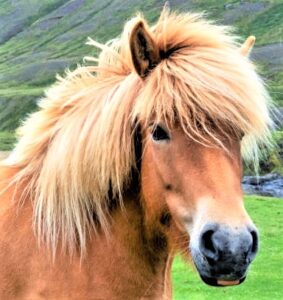» posted on Friday, September 30th, 2022 by Linda Lou Burton
A Horse Of Course
Linda Lou Burton posting from Center Hotels Plaza, Reykjavik, Iceland – No, it’s not a  pony! Icelandic horses are small –52-56 inches tall, which is often considered “pony size” but make no mistake, this unique animal is a horse. It’s the only breed of horse in Iceland; Icelandic law does not allow horses to be imported into the country, and any horse that is exported can never return. Any equine equipment coming into the country must be new or fully disinfected. These horses are well-protected; a Horse Naming Commission even protects the naming of horses to retain Icelandic names and pronunciations. Owners of Icelandic horses and their breeders register their horses in WorldFeng, a world database of Icelandic horses. More than 400,000 horses, alive and dead, are registered in the database.
pony! Icelandic horses are small –52-56 inches tall, which is often considered “pony size” but make no mistake, this unique animal is a horse. It’s the only breed of horse in Iceland; Icelandic law does not allow horses to be imported into the country, and any horse that is exported can never return. Any equine equipment coming into the country must be new or fully disinfected. These horses are well-protected; a Horse Naming Commission even protects the naming of horses to retain Icelandic names and pronunciations. Owners of Icelandic horses and their breeders register their horses in WorldFeng, a world database of Icelandic horses. More than 400,000 horses, alive and dead, are registered in the database.
What’s so special about the Icelandic horse? Let me begin a list: they are friendly and not easily spooked. They are hardy and easy to keep. They have a no-nonsense look – well-proportioned heads, short muscular necks, a long back, and strong, short legs. Their double coat gives them extra insulation for Iceland’s cold temperatures, and those coats come in many colors; there are over a hundred names in the Icelandic language for the various color patterns. Rick passed a few horses in the fields on the Golden Circle Tour today but they didn’t stop there; many tours include horseback riding however.
 Though the first horses were brought to Iceland by Norse settlers in the 900s, the horses you see today are a result of selective breeding over the centuries. Highly fertile and long-lived, they are “bred to the task” -some solely for horsemeat; some for pack and draft work; some for work under saddle. The Icelandic is a “five-gaited” breed – the walk, trot, and gallop that most horses do, plus the tolt and the flying pace. The tolt is a natural gait present from birth;
Though the first horses were brought to Iceland by Norse settlers in the 900s, the horses you see today are a result of selective breeding over the centuries. Highly fertile and long-lived, they are “bred to the task” -some solely for horsemeat; some for pack and draft work; some for work under saddle. The Icelandic is a “five-gaited” breed – the walk, trot, and gallop that most horses do, plus the tolt and the flying pace. The tolt is a natural gait present from birth;  it offers a smooth fast ride with no bounce; imagine the comfort in that! The flying pace is used for racing; horses that can perform both gaits are considered the best of the breed. The first breed society for the Icelandic horse was created in Iceland in 1904; today the breed is represented by organizations in 19 different nations, organized under the International Federation of Icelandic Horse Associations.
it offers a smooth fast ride with no bounce; imagine the comfort in that! The flying pace is used for racing; horses that can perform both gaits are considered the best of the breed. The first breed society for the Icelandic horse was created in Iceland in 1904; today the breed is represented by organizations in 19 different nations, organized under the International Federation of Icelandic Horse Associations.
 “Would you go horseback riding here if we had another day?” I asked Rick on the way back to our hotel. “Maybe,” he said. “The tolt sure sounds like a smoother ride than a 4×4.” Now there’s a thought! Tradition says you should never ride a horse whose name you don’t know, or understand. “You’d have to check out the horse’s name with the guide,” I told him. “Pick one named Farfús, it means likes to travel.”
“Would you go horseback riding here if we had another day?” I asked Rick on the way back to our hotel. “Maybe,” he said. “The tolt sure sounds like a smoother ride than a 4×4.” Now there’s a thought! Tradition says you should never ride a horse whose name you don’t know, or understand. “You’d have to check out the horse’s name with the guide,” I told him. “Pick one named Farfús, it means likes to travel.”
Our Farfús days are near the end. Tomorrow we go home. “Let’s pack,” was our goodnight. I’ve got more to tell you about Icelandic names, however. Next post?
WorldFeng Studbook of Origin https://www.worldfengur.com/
Center Hotels Plaza, Reykjavik, Iceland https://www.centerhotels.com/en/hotel-plaza-reykjavik
Next Post: Sons and Dottirs
